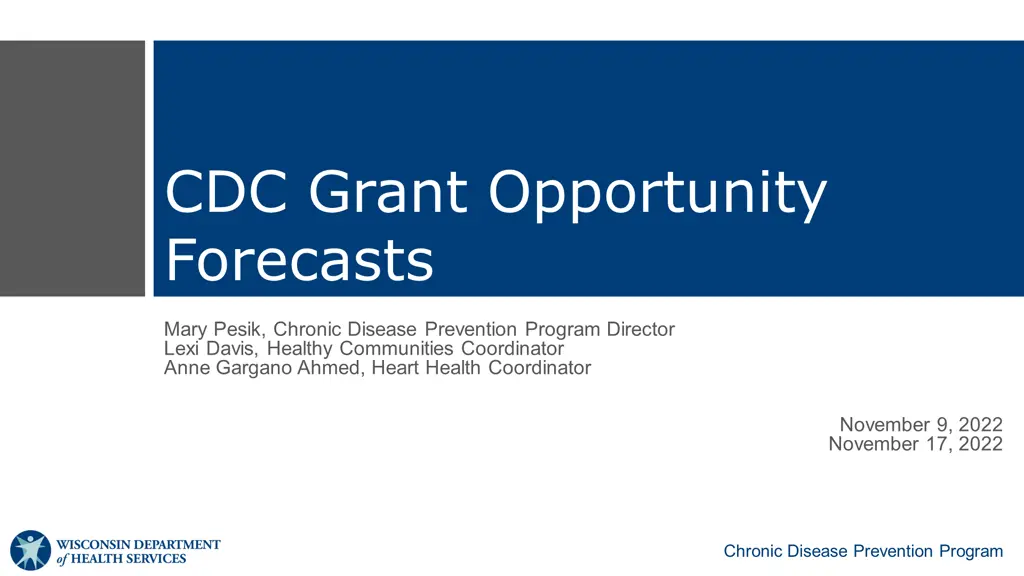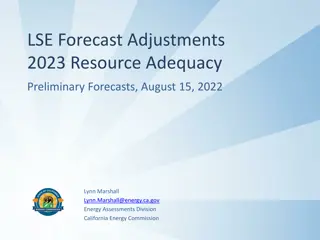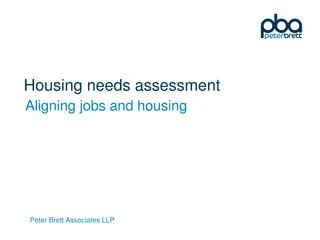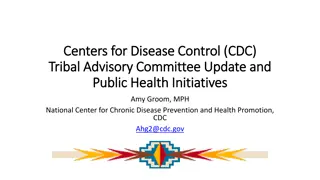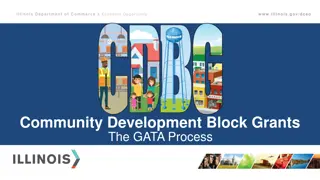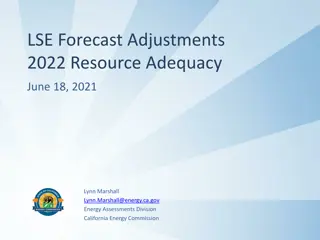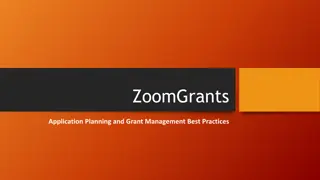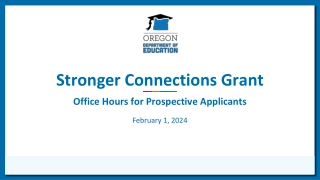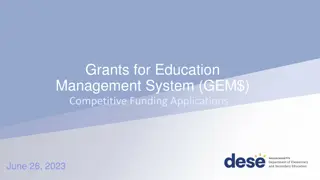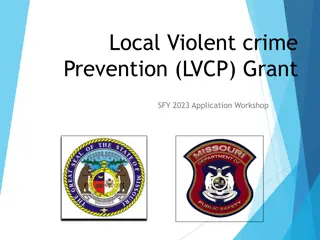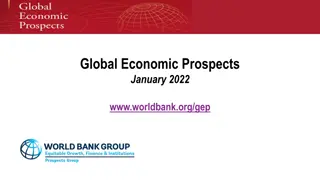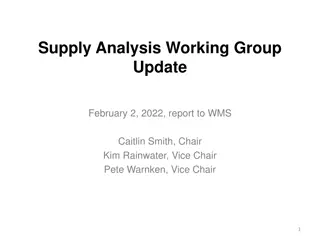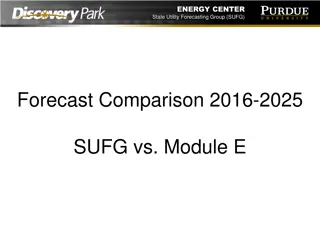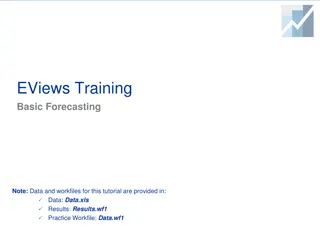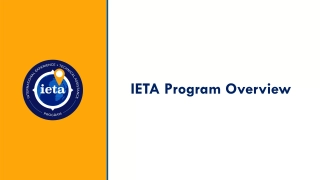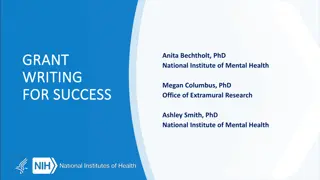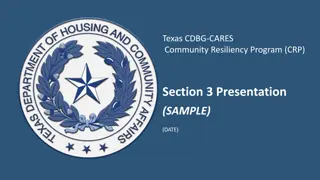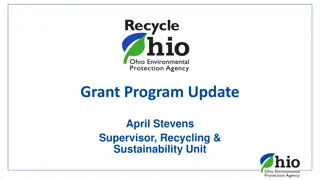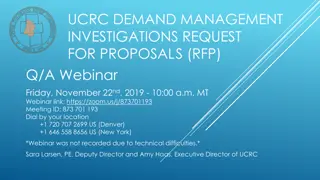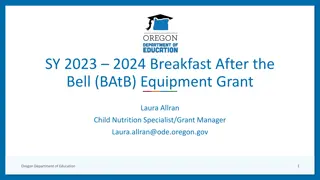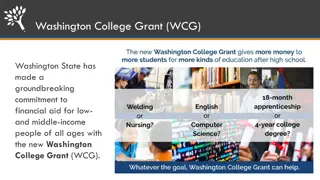CDC Grant Opportunity Forecasts
Explore upcoming CDC grant opportunities and strategies for chronic disease prevention. Learn about partner interest surveys and the timeline for funding.
Download Presentation

Please find below an Image/Link to download the presentation.
The content on the website is provided AS IS for your information and personal use only. It may not be sold, licensed, or shared on other websites without obtaining consent from the author. Download presentation by click this link. If you encounter any issues during the download, it is possible that the publisher has removed the file from their server.
E N D
Presentation Transcript
CDC Grant Opportunity Forecasts Mary Pesik, Chronic Disease Prevention Program Director Lexi Davis, Healthy Communities Coordinator Anne Gargano Ahmed, Heart Health Coordinator November 9, 2022 November 17, 2022 Chronic Disease Prevention Program
Agenda and Purpose Introduce partner interest survey process Share information about upcoming CDC grant opportunities Provide overview of current and anticipated chronic disease prevention strategies and activities Review timeline Note: enter your questions in the chat during the call 2 2
Acronym Definitions NOFO = Notice of Funding Opportunity CVD = Cardiovascular Disease CDPP = Chronic Disease Prevention Program SDOH = Social Determinants of Health NPAO = Nutrition, Physical Activity, and Obesity CDC = Centers for Disease Control and Prevention 3 3
Request for Partner Interest
Request for Partner Interest Potential partnerships for the 2023 NOFOs Online survey to provide brief detail on: o Organizational capacity o Strategy areas of interest o Implementation approach o Health equity capacity o Partnerships and collaboration o Requested funding Note: We can not guarantee funded partnerships 5 5
Requests for Partner Interest Seeking diverse group of partners: o Community (e.g., Local/Tribal Health Departments, coalitions, community-based organizations) o Health systems (payers and providers) o Statewide organizations (e.g., professional organizations, non-profits, health advocacy groups) Survey completed by: December 30, 2022 https://survey.alchemer.com/s3/7095146/CDPP- Partner-Request-for-Interest-Survey 6 6
Screen Views 7 7
Screen Views 8 8
Screen Views 11 11
Screen Views 14 14
Screen Views 15 15
2023 CDC Notice of Funding Opportunities
Anticipated 2023 Notice of Funding Opportunities Grant Funding range/year Estimated Release Date/Start Date January 6, 2023/ June 30, 2023 2320: A Strategic Approach to Advancing Health Equity for Priority Populations with or at Risk for Diabetes 2304: National Cardiovascular Health Program $850,000 - $1,250,000 (Competitive) $850,000 - $2,000,000 (Non-competitive) January 15, 2023/ June 30, 2023 2305: Innovative Cardiovascular Health Program $400,000 - $1,200,000 (Competitive) February 11, 2023/ September 30, 2023 2312: State Physical Activity and Nutrition Program $600,000 - $1,300,000 (Competitive) January 12, 2023/ September 30, 2023 17 17
What do we know? Estimated grant timelines o 60-day turnaround from posting (45 days for DHS review) High-level grant descriptions Emphasis on health equity, social determinants of health (SDOH), and reaching priority populations DHS requires a documented process to establish funded partnerships 18 18
Priority Populations From CDC NOFO Forecasts Those who have systematically experienced greater obstacles to health based on their racial or ethnic group; religion; socioeconomic status; gender; age; mental health; cognitive, sensory, or physical disability; sexual orientation or gender identity; geographic location; or other characteristics historically linked to discrimination or exclusion. 19 19
Priority Populations Strategies should be prioritized in communities and among populations that have experienced inequitable distribution of power and resources CDC may include guidance for determining populations o Incidence and prevalence o Social Vulnerability Index o Census data 20 20
Key Outcomes Decrease percent of individuals with uncontrolled diabetes (A1c >9%) Increase percent of individuals with controlled high blood pressure (<140/90) Increase percent of individuals with high blood cholesterol who are prescribed a statin Increase opportunities for and access to safe physical activity 21 21
Increase availability and access to healthy nutrition environments Increase settings with evidence-based maternity care practices Decrease percent of individuals who are within the overweight and obese weight status 22 22
The National Cardiovascular Health Program (2304) Previous iteration: 1815 Category B Grant focus: o Implement and evaluate evidence-based strategies contributing to the prevention and management of CVD in populations at the highest risk. o Address social and economic factors to help health systems respond to social determinants present in their communities to offer those at risk of, or burdened with CVD, the best health outcomes possible. 24 24
The Innovative Cardiovascular Health Program (2305) Previous iteration: 1817 Category B Grant focus: o Health system interventions to prevent, control, and manage high blood pressure and cholesterol o Improve continuity of care across health care settings o Maximize use of electronic health record data o Use technology to improve medication adherence 25 25
Grant focus: o Integrate Community Health Workers o Support community and clinical links and partnerships o Develop partnerships to improve cardiovascular disease in priority populations Address SDOH, stress/mental health, health inequity, and injustice 26 26
Current Grant Funded Efforts Electronic Health Records/Health Information Technology Team-based care o Pharmacist care team integration Medication Therapy Management and Collaborative Practice Agreements o Community Health Worker integration Self-measured blood pressure monitoring o Clinical and community-based settings Hybrid cardiac rehab 27 27
Resources Million Hearts 2027 Priorities The Surgeon General s Call to Action to Control Hypertension Fact Sheets for Public Health Professionals and State and Local Governments Set Your Heart on Health Toolkit: A toolkit for improving hypertension and cardiovascular outcomes American Heart Association s High Blood Pressure Resources American Medical Association s Checklists for Improving Blood Pressure Control 28 28
Resources The Community Guide, Community Preventive Services Task Force's Team-Based Care to Improve Blood Pressure Control Pharmacy Society of Wisconsin's Wisconsin Pharmacy Quality Collaborative National Association of Community Health Workers Centers for Disease Control and Million Hearts 29 29
A Strategic Approach to Advancing Health Equity for Priority Populations with or at Risk for Diabetes (2320) Previous iteration: 1815 Category A Grant focus: o Prevent or delay onset of type 2 diabetes among adults and improve self-care practices, quality of care, and early detection of complications o Support implementation of evidence-based, family-centered childhood obesity interventions o Achieve statewide reach and reduce health disparities for priority populations o Implement evidence-based diabetes prevention and management strategies 31 31
Current Grant Funded Efforts National Diabetes Prevention Program (National DPP) Diabetes self-management education and support (DSMES) Pharmacist and Community Health Worker integration into care teams 32 32
National Diabetes Prevention Program Developing Screening-Testing-Referral processes Increasing referrals and enrollment of priority populations Insurer Community of Practice and Umbrella Hub Arrangement Prediabetes and National DPP Campaign Prediabetes risk test vanity URL www.diabetes.org/widhsrisktest 33 33
Diabetes Self-Management Education and Support (DSMES) Increasing referrals to DSMES Telehealth Pharmacist care team integration o DSMES in pharmacy settings o Medication Therapy Management o Collaborative Practice Agreements Community health worker diabetes education and referrals 34 34
Resources CDC Diabetes Self-Management Education and Support (DSMES) Toolkit American Diabetes Association-recognized andAssociation of Diabetes Care and Education Specialists-accredited DSMES Program Site Registry CDC Interactive DiabetesAtlas: diabetes data by county to investigate local diabetes burden The National Diabetes Prevention Program background and research 35 35
Resources American Medical Association/CDC Prevent Diabetes STAT toolkit to help health care teams screen, test and refer at risk patients to in- person or online diabetes preventionprograms. National DPP Resources for Engaging Health Care Providers CDC National DPP Information for Health Care Professionals CDPP Promotional Resources found on www.PreventDiabetesWI.org National Association of Community Health Workers CDC Job Aid: CHWs in Diabetes Management and Prevention 36 36
Nutrition, Physical Activity, and Obesity (NPAO)
The State Physical Activity and Nutrition Program (2312) Previous iteration: SPAN (1807) Note: CDPP does not have this funding. Grant focus: o Support activities to implement evidence-based strategies and leverage resources from various stakeholders and sectors related to poor nutrition and physical inactivity. o Work with state and local partners to improve nutrition and access to safe physical activity, including breastfeeding, early care and education, and family healthy weight programs. 38 38
Current Efforts Partner engagement Breastfeeding support in partnership with Maternal and Child Health and WIC programs Nutrition security support in partnership with Wisconsin SNAP-Ed Healthy Early Wisconsin Physical Activity and Nutrition Road Map dissemination 39 39
Anticipated New Strategy Family Healthy Weight Programs o Nutrition and physical activity skills and counseling o Family-centered design o Address SDOH context o Awareness of bias, stigma, and shame o Program delivery o >26 hours over 2-12 months o Setting: Clinical or Community o Various flexibility 40 40
Resources Wisconsin Physical Activity and Nutrition Road Map Early Care and Education Initiatives Breastfeeding Initiatives Active Community Initiatives CDC Initiatives to Prevent or Manage Childhood Obesity in Healthcare CDC State Physical Activity and Nutrition 41 41
2023 Notice of Funding Opportunities Summary Grant Funding range/year Estimated Release Date/Start Date January 6, 2023/ June 30, 2023 2320: A Strategic Approach to Advancing Health Equity for Priority Populations with or at Risk for Diabetes 2304: National Cardiovascular Health Program $850,000 - $1,250,000 (Competitive) $850,000 - $2,000,000 (Non-competitive) January 15, 2023/ June 30, 2023 2305: Innovative Cardiovascular Health Program $400,000 - $1,200,000 (Competitive) February 11, 2023/ September 30, 2023 2312: State Physical Activity and Nutrition Program $600,000 - $1,300,000 (Competitive) January 12, 2023/ September 30, 2023 42 42
2023 Notice of Funding Opportunities Summary Grant Forecast links 2320: A Strategic Approach to Advancing Health Equity for Priority Populations with or at Risk for Diabetes https://www.grants.gov/web/grants/view- opportunity.html?oppId=342950 2304: National Cardiovascular Health Program https://www.grants.gov/web/grants/view- opportunity.html?oppId=342935 2305: Innovative Cardiovascular Health Program https://www.grants.gov/web/grants/view- opportunity.html?oppId=342936 2312: State Physical Activity and Nutrition Program https://www.grants.gov/web/grants/view- opportunity.html?oppId=342954 43 43
Desired Outcomes Performance Measures (PMs) used to indicate progress CDC Required Grant Strategies Example: Example: Increased access to and coverage for the National DPP lifestyle change program for people with prediabetes Increased community clinical links that facilitate referrals and provide support to enroll and retain participants in the National DPP lifestyle change program Improve access to, participation in, and coverage for the National DPP lifestyle change program for people with pre- diabetes, particularly in underserved areas. 45 45
HOW? Partner Roles CDC Required Grant Strategies Desired Outcomes 46 46
Cross-Cutting Partner Roles Use data to identify populations of focus Develop strategic partnerships Convene multi-sector partners Facilitate community-clinical linkages Align work with local context (priorities and needs) Engage and incorporate populations of focus Support and engage community-based organizations 47 47
Policy, Systems, and Environmental Change Approaches that promote healthy behaviors and make physical activity and healthy eating easier and more accessible Drive change at multiple levels (e.g., within an organization or health system, neighborhood, community, state) Sustainable change, moves beyond one-time events or individual education 48 48
Resources CDC Community-Clinical Linkages Health Equity Guide National Association of County and City Health Officials (NACCHO) Community Chief Health Strategist Competencies Foundational Public Health Services Factsheet NACCHO Public Health 3.0 Issue Brief CDC Meaningful Community Engagement for Health and Equity CDC Framework for Program Evaluation in Public Health 49 49
Complete the Interest Survey https://survey.alchemer.com/s3/7095146/CDPP-Partner-Request-for- Interest-Survey Complete by December 30, 2022 Note: the survey link, PDF and recording will be posted on the Chronic Disease Prevention Program website, https://www.dhs.wisconsin.gov/disease/chronic-disease.htm 51 51
After Interest Survey CDPP will Review and summarize responses Identify gaps Additional outreach, if needed 52 52
After NOFO Released Will contact those who expressed interest in specific strategy area(s) Will be a rapid turn-around for information Various partnership options o Funded partner o Collective action partner o DAG, Heart Health Alliance or healthTIDE member 53 53
After NOFO Released Important considerations o Fit with NOFO guidance, strategies and performance measures, and available funding o Identification of populations of focus o Geographic distribution in state o Good standing with DHS requirements o Ability to participate in the planning process timeline 54 54
